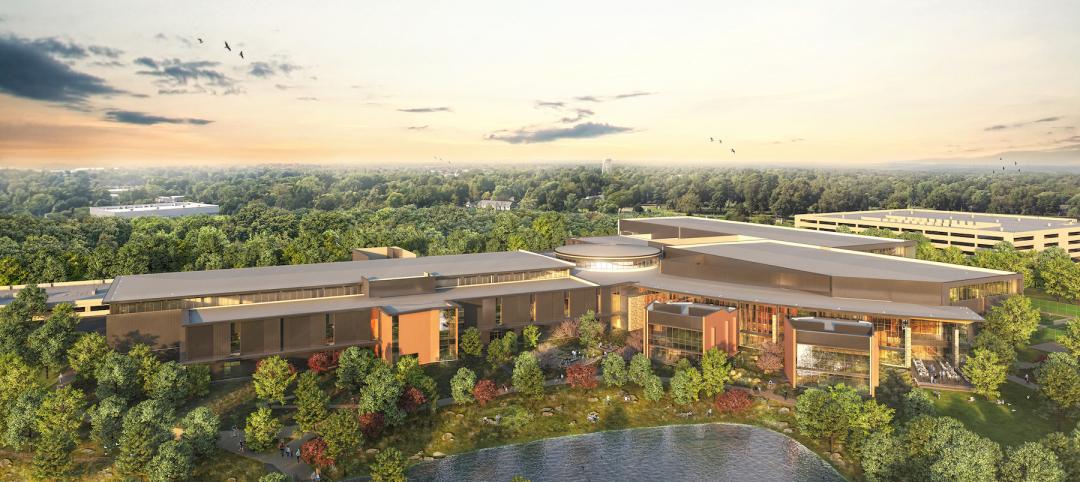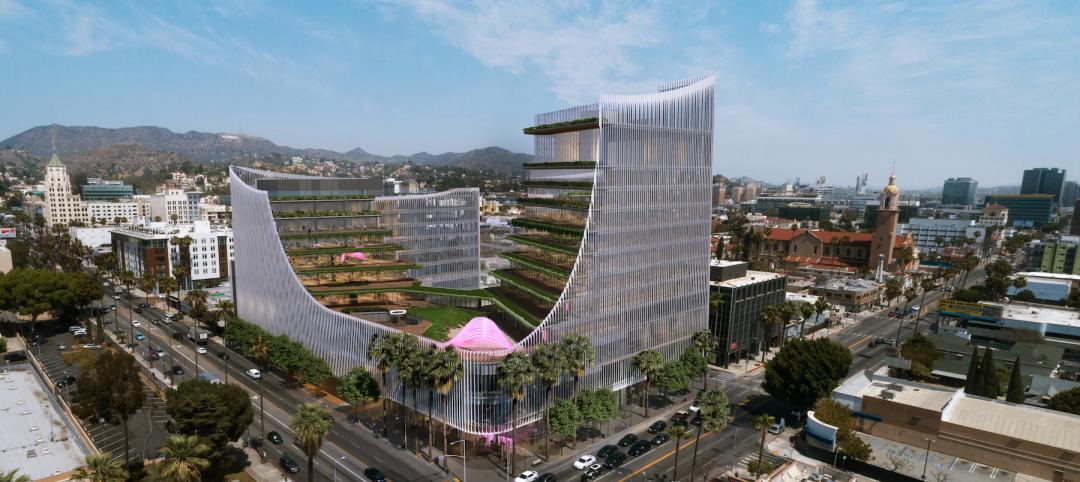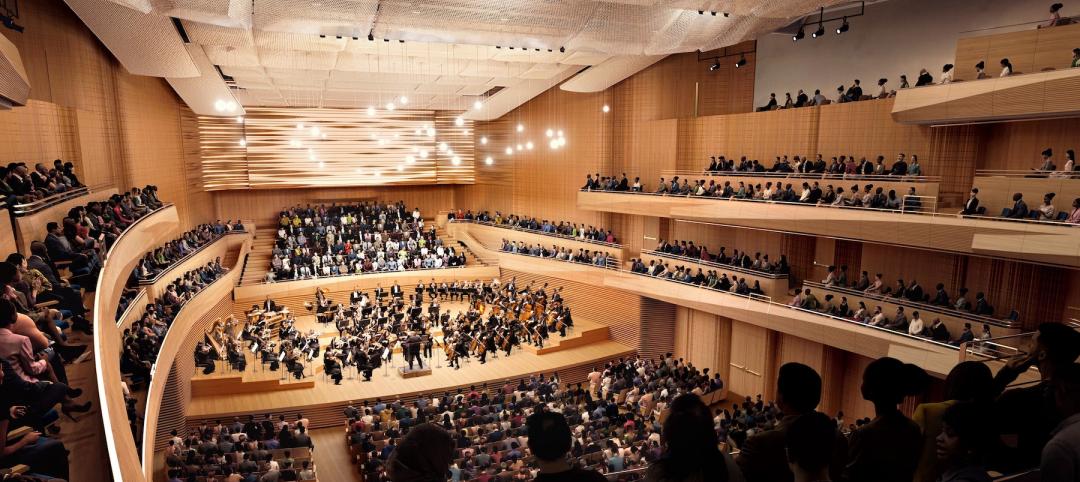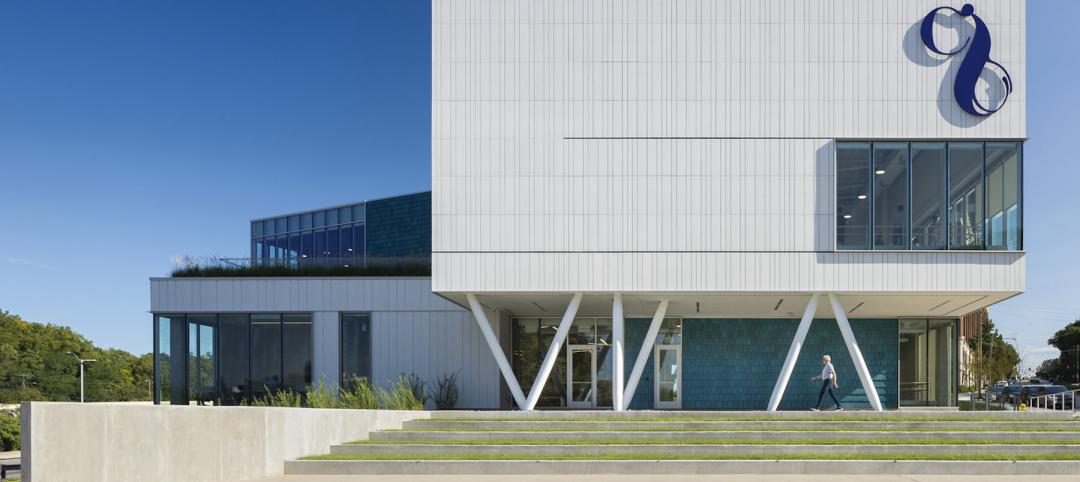 |
|
Design for the Holocaust and Human Rights Center of Maine is representative of a flower in bloom, complete with petals that shelter the circular exhibit space. The center connects to the Bennett Katz Library. Photos: Shepley Bullfinch |
The Holocaust and Human Rights Center of Maine was founded in 1985, but the organization didn't have a permanent home until May 2008. That's when the Michael Klahr Center, which houses the HHRC, opened on the Augusta campus of the University of Maine.
The design, by Boston-based architects Shepley Bulfinch Richardson & Abbott, was selected from among more than 200 entries in a university-sponsored competition. The winning project, a conceptualized flower in bloom, was created by a group of young architects at Shepley Bulfinch who imagined four petal-like forms growing out of the ground—symbolic of the seeds of democracy and freedom.
“There are still so many human rights issues out there today, so the flower blossoms are representative of new life coming back when conditions are right,” says Angela Watson, a principal at Shepley Bulfinch and mentor to the young architects.
 |
|
The Building Team utilized BIM to check the demands and capabilities of the petal forms and determine the proper petal radii, which cut the cost of bending the shell steel by half. The finished petals are clad in copper. |
It was Watson who introduced the HHRC project to the firm. When she learned of the University of Maine's design competition back in 2004, she organized a separate in-house competition as a way to give the firm's young bloods a chance to “flex their design muscles,” as she put it. The entire firm voted, and the two winning designs were entered in the HHRC competition, with one taking the prize.
At 6,300 sf, the Michael Klahr Center isn't a large building. The space is apportioned throughout a single level that includes a circular exhibit space in the center as well as offices and education space. However, its sculptural forms were complex enough for the Building Team, which included structural engineer Simpson Gumpertz and Heger of Waltham, Mass., to experiment with BIM.
Not a big deal now, but BIM was fairly new in 2004 when design began, turning this project into a BIM pilot for Shepley Bulfinch. The Building Team used BIM to explore many different construction options, including cast-in-place concrete, glulam wood beams, and steel. They found that cast-in-place would push the project over the $1.8 million budget cap and glulam would make the petals too thick. Their BIM model helped them decide that steel framework was the most efficient and economical solution.
Steel construction enabled some portions of the building to be shop fabricated, which saved time. General contractor Wright-Ryan Construction, Portland, Maine, cut construction time even more by framing large portions of the small building using wide-flange noncomposite steel beams and columns, with the lateral load system consisting of structural steel concentrically braced frames with hollow structural section (HSS) brace members.
But it was the complex design of the steel petals that really tested the Building Team's mettle.
The SGH structural engineering team developed an innovative structural system that consisted of a grid of HSS sections using curved HSS 8x8s as the ribs along the meridians of the spherical sections of the petals and straight HSS 4x4s along the parallels of latitude of the pedals. The HSS grids, braced and moment-connected in-plane, allowed the petals to act as shells. Three-inch-diameter structural steel columns pierced the petals and provided additional structural support. The BIM model enabled the team to check the demands and capabilities of the petals and determine the proper petal radii, which cut the cost of bending the shell steel by half.
Wood-framed box beams (made of 2x4s and plywood) were incorporated into the spans between the rib framing; this allowed the four petals to be sheathed in plywood, over which the standing seam copper roof panels were installed.
“This building is the perfect story,” says Watson. “It's a unique design from a young, talented team that overcame challenges of budget, schedule, and material and created a place that will have lasting impact.”
Related Stories
Giants 400 | Aug 20, 2022
Top 180 Architecture Firms for 2022
Gensler, Perkins and Will, HKS, and Perkins Eastman top the rankings of the nation's largest architecture firms for nonresidential and multifamily buildings work, as reported in Building Design+Construction's 2022 Giants 400 Report.
Giants 400 | Aug 19, 2022
2022 Giants 400 Report: Tracking the nation's largest architecture, engineering, and construction firms
Now 46 years running, Building Design+Construction's 2022 Giants 400 Report rankings the largest architecture, engineering, and construction firms in the U.S. This year a record 519 AEC firms participated in BD+C's Giants 400 report. The final report includes more than 130 rankings across 25 building sectors and specialty categories.
Cultural Facilities | Aug 5, 2022
A time and a place: Telling American stories through architecture
As the United States enters the year 2026, it will commence celebrating a cycle of Sestercentennials, or 250th anniversaries, of historic and cultural events across the land.
Museums | Jun 28, 2022
The California Science Center breaks grounds on its Air and Space Center
The California Science Center—a hands-on science center in Los Angeles—recently broke ground on its Samuel Oschin Air and Space Center.
Headquarters | Jun 21, 2022
Walmart combines fitness and wellness in associates’ center that’s part of its new Home Office plan
Duda | Paine’s design leads visitors on a “journey.”
Cultural Facilities | Jun 15, 2022
Gehry-designed Children’s Institute aims to foster community outreach in L.A.’s Watts neighborhood
The Children’s Institute (CII) in Los Angeles will open a 200,000-sf campus designed by Frank Gehry this summer.
Cultural Facilities | Jun 10, 2022
After 10 Years, Taiwan’s new Taipei Music Center Reaches the Finish Line
RUR Architecture has finished the Taipei Music Center (TMC), turning a 22-acre (9-hectare) site into a new urban arts district.
Projects | Mar 24, 2022
A Hollywood home for creatives
A Hollywood development will serve as a collaborative center for artists, students, and those in the entertainment industry.
Cultural Facilities | Mar 10, 2022
A ‘reimagined’ David Geffen Hall in New York is on track to open this fall
Its half-billion-dollar reconstruction is positioning this performance space as an integral key to luring people to the city again.
Performing Arts Centers | Mar 8, 2022
Cincinnati Ballet’s new center embodies the idea that dance is for everyone
Cincinnati Ballet had become a victim of its own success, according to company president and CEO Scott Altman. “We were bursting at the seams in our old building. We had simply outgrown the facility,” Altman told the Cincinnati Enquirer.
















